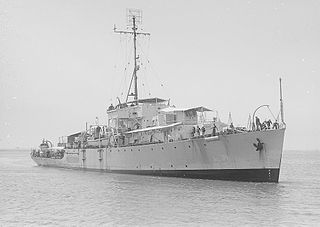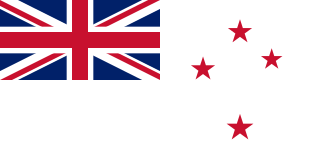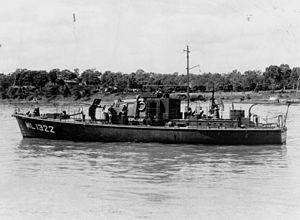
HMAS Lachlan (K364/F364) was a River-class frigate that served the Royal Australian Navy (RAN) from 1945 to 1949. The vessel was later transferred to the Royal New Zealand Navy serving as surveyor until 1975 and was eventually scrapped in 1993.

HMAS Echuca (J252/M252), named for the town of Echuca, Victoria, was one of 60 Bathurst-class corvettes constructed during World War II, and one of 36 initially manned and commissioned by the Royal Australian Navy (RAN).

HMAS Inverell, named for the town of Inverell, New South Wales, was one of 60 Bathurst-class corvettes constructed during World War II, and one of 36 initially manned and commissioned solely by the Royal Australian Navy (RAN).

The Royal New Zealand Navy is the maritime arm of the New Zealand Defence Force. The fleet currently consists of nine ships. The Navy had its origins in the Naval Defence Act 1913, and the subsequent acquisition of the cruiser HMS Philomel, which by 1921 had been moored in Auckland as a training ship. A slow buildup occurred during the interwar period, and then in December 1939 HMS Achilles fought alongside two other Royal Navy cruisers at the Battle of the River Plate against the German ship, Graf Spee.

HMNZS Resolution (A14) was a hydrographic ship of the Royal New Zealand Navy (RNZN). Originally the United States Naval Ship USNS Tenacious (T-AGOS-17), the Stalwart-class ocean surveillance ship was used by the United States to locate and track Soviet submarines from 1989 to 1997, when she was transferred to the RNZN for use as a hydrographic survey ship. She served until 27 April 2012. She was subsequently sold to EGS Group, a private surveying company, and renamed RV Geo Resolution.

The harbour defence motor launch (HDML) was a 72 ft (22 m) long British-designed motor vessel used for harbour defence during World War II. Nearly 500 were built by numerous Allied countries during the war.

HMNZS Waikato (F55) was a Leander Batch 2TA frigate of the Royal New Zealand Navy (RNZN). She was one of two Leanders built for the RNZN, the other being the Batch 3 HMNZS Canterbury. These two New Zealand ships relieved British ships of the Armilla patrol during the Falklands conflict, freeing British ships for deployment.

HMNZS Wakakura (P3555) was a Moa-class inshore patrol vessel of the Royal New Zealand Navy. It was commissioned in March 1985 for the Naval Volunteer Reserve.

The Fairmile B motor launch was a very numerous class of motor launch produced in kit form by British boatbuilder Fairmile Marine, and then assembled and fitted out by numerous boatyards during the Second World War to meet the Royal Navy's coastal operation requirements.

HMNZS Rotoiti (F625) was a Loch-class frigate of the Royal New Zealand Navy (RNZN), which had formerly served in the British Royal Navy as HMS Loch Katrine at the end of World War II.

HMNZS Hawea (F422), formerly HMS Loch Eck (K422), was one of six Loch-class frigates that served in both the Royal Navy (RN) and the Royal New Zealand Navy (RNZN). The ship was laid down by Smiths Dock on 25 October 1943, launched on 25 April 1944 and commissioned into the Royal Navy as HMS Loch Eck on 7 November 1944.

HMNZS Wakakura (T00) was originally a First World War Castle-class naval trawler built in Canada. Ordered by the Admiralty, the vessel, named TR 1, was loaned to the Royal Canadian Navy for use on the East Coast of Canada. She was purchased by New Zealand in 1926 and transferred to the Royal New Zealand Navy when it was established in 1941.

HMNZS Kahu (A04) was a Moa-class inshore patrol vessel of the Royal New Zealand Navy. She was launched in 1979 as the lead boat of her class, modified to function as a diving tender. She was initially named HMNZS Manawanui (A09), the second of soon to be four diving tenders with this name to serve in the New Zealand Navy. As a diving tender she participated in the exploration and salvage work of the wreck MS Mikhail Lermontov in March 1986.

Coastal Forces was a division of the Royal Navy established during World War II. It consisted of small coastal defence craft such as motor launches, submarine chasers, air-sea rescue launches, motor gun boats and motor torpedo boats. It did not include minesweepers, naval trawlers or landing craft. This article is about the equivalent boats used in the Royal New Zealand Navy (RNZN).
HMNZS Maori (P3570) was a Fairmile B Motor Launch of the Royal New Zealand Navy

HMNZS Tui (T234) was a Bird-class minesweeper of the Royal New Zealand Navy. She was commissioned in 1941 for minesweeping and anti-submarine roles. Tui was the first of two ships with this name to serve in the Royal New Zealand Navy and was named after a native bird from New Zealand.

HMS Philomel, later HMNZS Philomel, was a Pearl-class cruiser. She was the fifth ship of that name and served with the Royal Navy. After her commissioning in 1890, she served on the Cape of Good Hope Station and later with the Mediterranean Fleet.

Vice Admiral Sir Peter Phipps, was a senior officer of the Royal New Zealand Navy (RNZN) from the 1940s to 1960s.
HMNZS Manawanui was a naval tug which was modified for use as a diving tender by the Royal New Zealand Navy (RNZN). Originally intended for service with the United States Navy as a tug, the vessel was built in 1945 and transferred to the New Zealand Marine Department, which employed her in Waitemata Harbour before transferring the ship to the RNZN in 1948. She was converted to a diving tender in 1953 and served out her time in the RNZN in this role, before being decommissioned in 1978 and sold to the Paeroa Historic Maritime Park. The engine is now on display at the Whangarei Stationary Engine Club.

Commander Gordon Bridson, was a New Zealand swimmer who won two silver medals at the 1930 British Empire Games. He was also in the New Zealand Royal Naval Volunteer Reserve and in the Second World War, he served in the Royal New Zealand Navy. Seconded to the Royal Navy in 1940, he commanded a minesweeper vessel that accompanied coastal convoys along the English Channel. He was later the commander of the minesweeper HMNZS Kiwi which, with her sister ship Moa, sunk the Japanese submarine I-1 off Guadalcanal in the Solomon Islands.


















